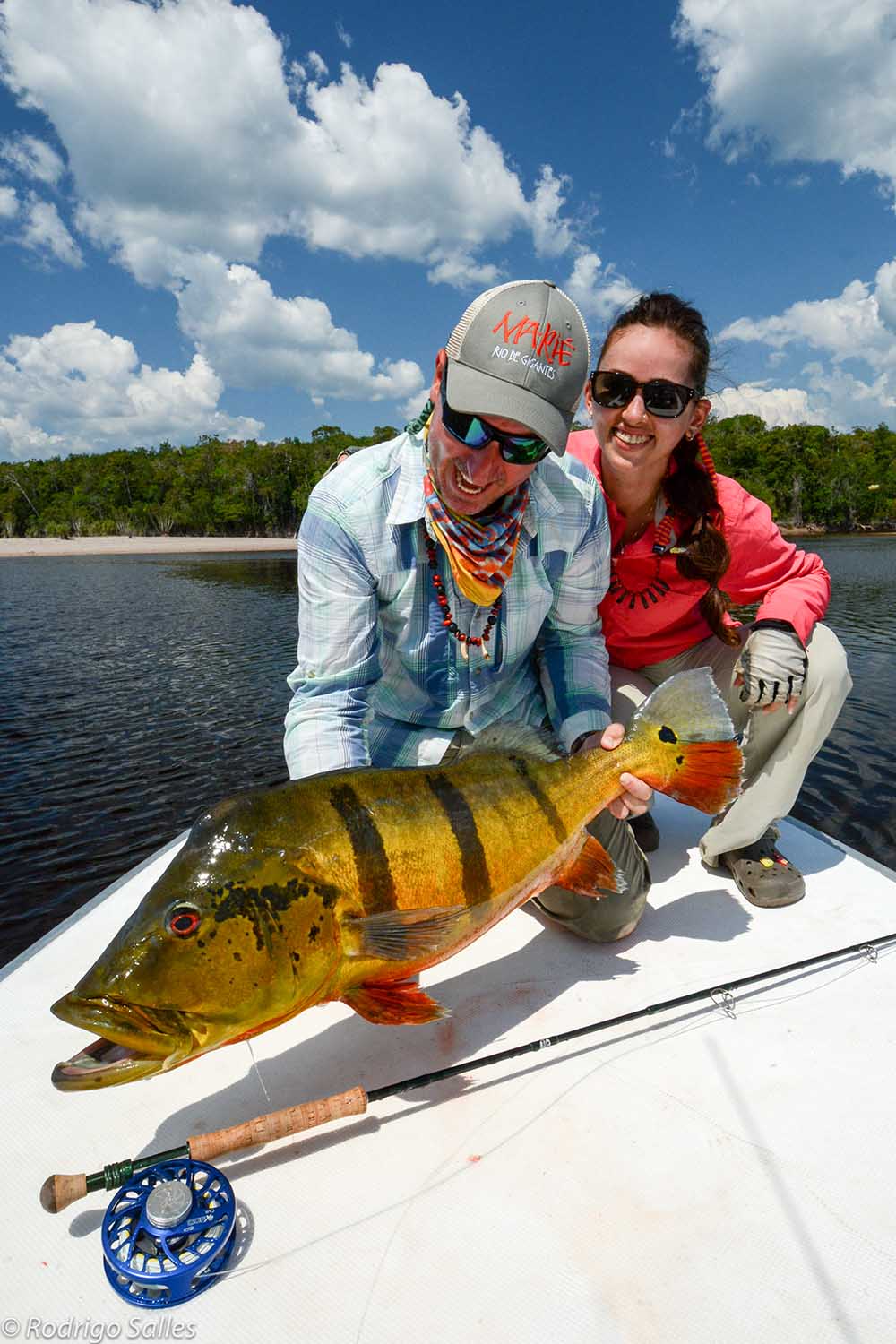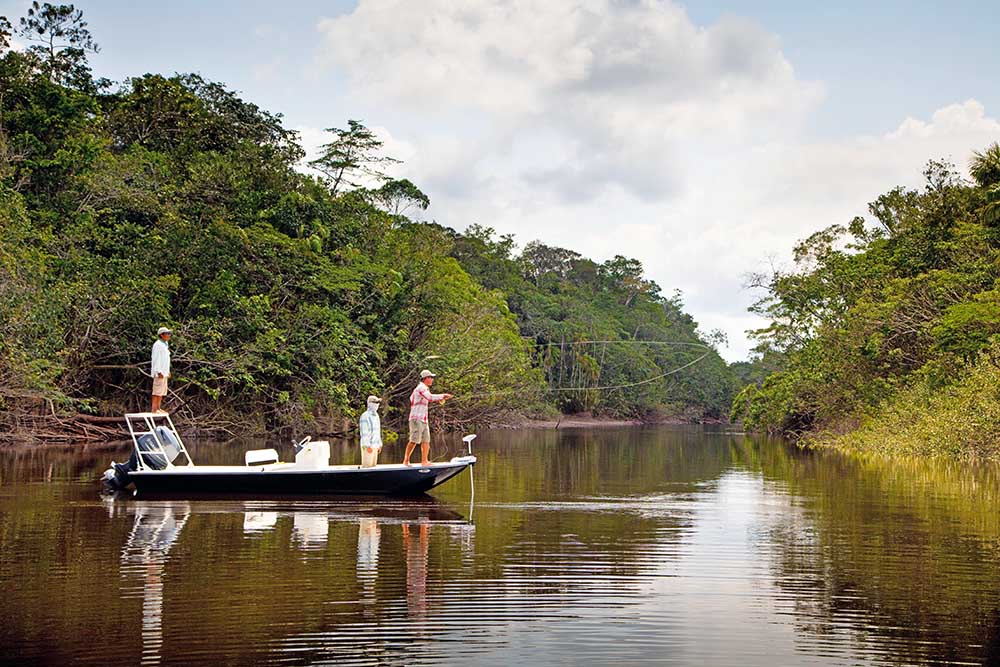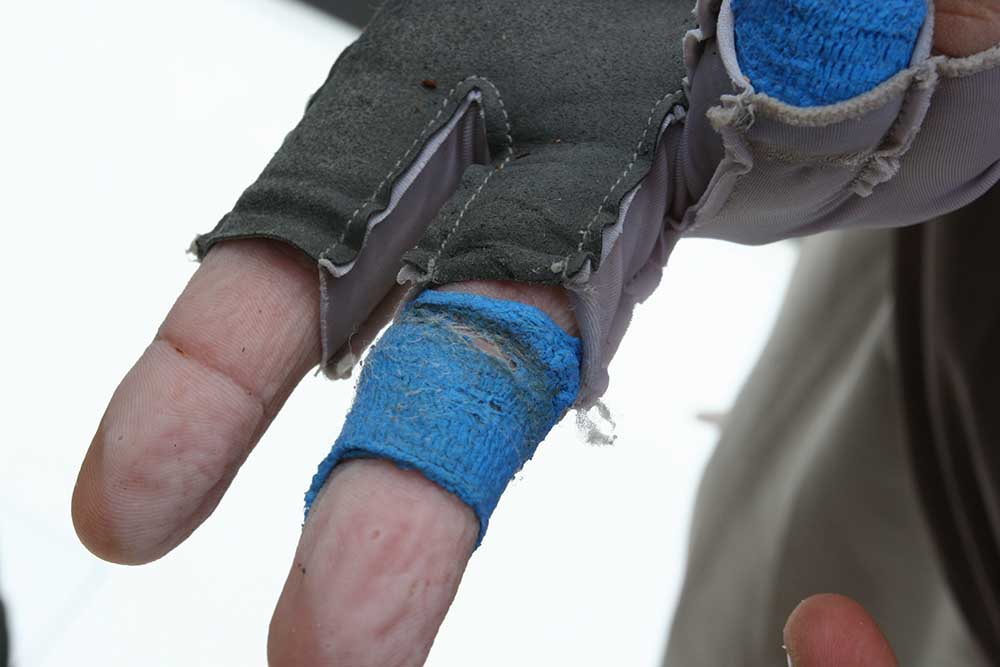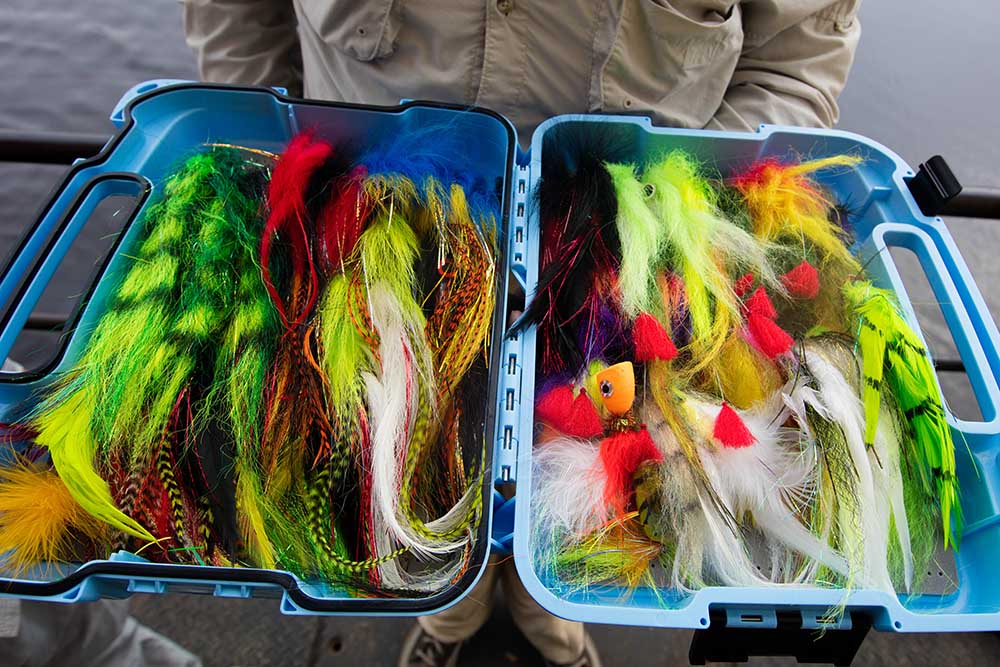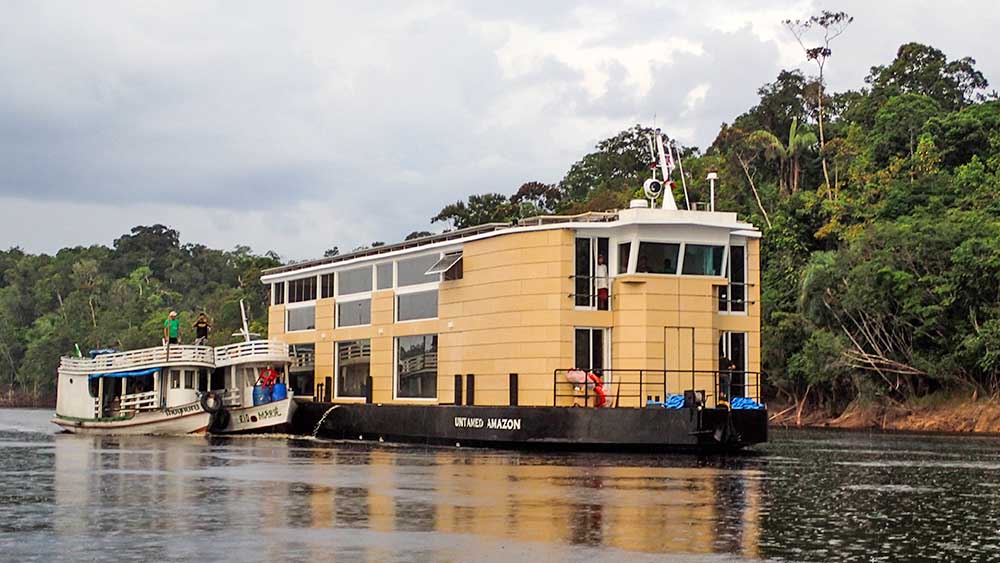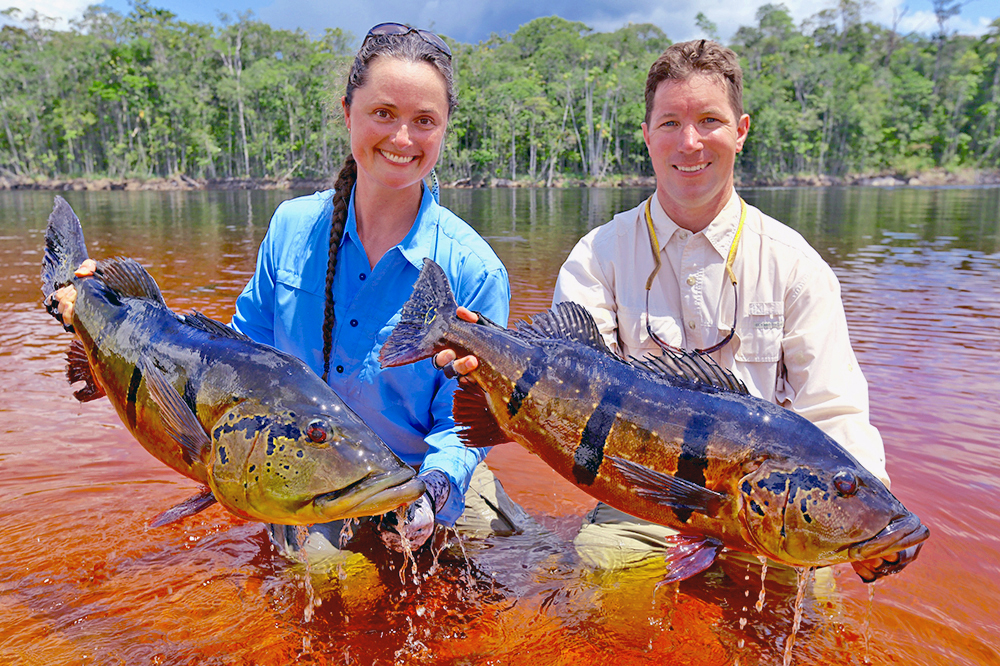An Interview with Mike Michalak, Patrick Pendergast, Justin Miller, Mike Mercer and Michael Caranci from The Fly Shop, Redding, CA.
Q: Fly Fishing at Rio Marié Lodge in the Brazilian jungle has only been available since 2014. What makes the fishing opportunities at Rio Marié so unique and outstanding?
A: The sheer number of massive peacocks found in the Rio Marié is really what separates it from other rivers in Amazonia. Peacock bass over 20 pounds are extremely rare; the majority of lodges land only peacock bass in the 20 pound range for their entire season. The Rio Marié recorded an unbelievable number of these trophies this year, with nearly half of the anglers landing a fish over 20 lbs., and a few knocking on the All- Tackle World Record door by landing fish in excess of the 25 pound mark.
The Rio Marié has so much more to offer than just trophy fish though. Anglers can often land up to 50 butterflies (smaller species of peacock) a day if they want to target them. These fish are aggressive to poppers and streamers alike.
Access to over 700 private kilometers of river, all the way up to the headwaters, also gives the guides at the Rio Marié a huge advantage, as they are able to get above high, rising water in a hard rain. The extraordinarily comfortable houseboat is able to move to the upper reaches and have clean, fishable river when the rest of the Amazon’s fish are swimming around in the drowned jungle during periods of flooding.
Rio Marié is entirely located inside an extensive Indian Territory, an area of more than 2 million hectares. This untouched environment has more than 800 kms of rivers, 180 known creeks, 60 lakes, and three major tributaries. It’s also worth noting that the Rio Marié is the first river in the Amazon Basin where the Brazilian government officials and their professional biologists have collaborated with the local natives to protect the interests of the indigenous tribe, while simultaneously creating a fly fishing only, catch-and-release angling preserve.
Q. What can you tell us about the fisheries and river systems the anglers at Rio Marié will experience?
A: The waterways are very complex and diverse on the Rio Marié. Again, due to the sheer size of our fishery (close to 500 miles) that our guides have access to, there is a seemingly endless supply of different types of water in which to target peacock bass – in all water conditions. We have big water and a great lagoon system in the lower river that we fish when the water is low. If the water comes up, we retreat to the headwaters where there is still clean water that is not pushed back into the trees (which makes the peacocks inaccessible). These upper stretches have tons of oxbows and ferraduras (loop lagoons or horseshoe lagoons) of all sizes, as well as back bays off of the main current, sandbars for sight-casting to suspended peacocks, and smaller hidden lagoons you sometimes have to cut and drag the boat into. We also have access to 2 major named tributaries of the Marié that provide another few hundred kilometers of fishable water. There is fishable and productive water on the Rio Marié at every water level we have encountered in the first 2 years. It is an unbelievably resilient river and extremely user-friendly to fly rodders.
Q: How do the fisheries at Rio Marié challenge conventional fly fishing rods and gear?
A: The thing with really giant peacock bass is that you can’t let them run after you’ve set the hook, or they’ll charge right back into the structure and break you off, just about every time. If you are to have a prayer of landing a fish in the 20-pound range you have to put a lock on their initial surge and fight down-and-dirty. You really get to feel every ounce of power the fish has because of this, yet this is also what makes life really hard on our light fly tackle. We run 40-60 pound level fluorocarbon leaders, so we can put the wood to them, but this often leads to fly rods exploding…literally! Most fly lines – even in the 8wt to 10wt class – have lighter cores than these leaders, so we have been breaking tons of fly lines, as well as rods, on monster fish. The fancy disc drags on our reels are not much help, since when we cast and then strip in the line it is loosely piled on the deck in front of us…so when we hook a fish we clamp down and don’t let him take the line, using our own fingers as the drag system. If the line doesn’t explode, and you are properly fighting the fish from the butt of the rod, your fingers are usually the link in the chain that takes all of the abuse. More than one grown man has screamed out loud as a fly line burned them through their glove or tape as a monster peacock refuses to be stopped on its way back to the wood.
Also, because we are often primarily targeting trophy fish on the Marié, we fish larger-than-normal flies most of the time, so a rod than can comfortably cast big (5”-7”) flies all day, every day, without wearing out the fisherman, is important.
Q: What were some of the specific requirements you expressed when working with Winston in the development of the new Boron III Plus Jungle rods?
A: First and foremost, the rod had to be castable all day long. It shouldn’t wear you down, so it has to be light, smooth and powerful, able to deliver long casts with big flies without making the angler overexert themselves. In saltwater you might make 50 to 100 casts a day if you are bonefishing and are into them…even when it’s good, bonefishing involves a lot of time stalking, without casting. Peacock bass fishing is relentless, all day long casting, covering the water thoroughly, often making 500-800 casts a day; your rod better be doing the work for you or you will be toast, with a jelly arm. Casting 6-inch streamers on 8wt and 9wt rods all day, and making it easy, was a tall order, and we needed a tool that could handle the job. The new Winston Boron III Plus rods are the ticket. They are smooth-casting, powerful tools that you can throw all day, rods with extra integrity built into the blank and components that will take the abuse. These fly rods are the best tools we have found for the job of tackling giant peacock bass and we couldn’t be more impressed by what our field experience with these rods has proven.
Q: What recommendations did you provide for Winston in the development of the Jungle rods and the fishing in Rio Marié?
A: We were super excited that Winston turned to The Fly Shop to help develop the new Jungle rods. We already had an 8-week test season under our belts on the Rio Marié, and were scratching our heads on what kind of specialized equipment we could find to help tame these beasts. Our first line of order was with the rods. We had taken all the conventional saltwater fly rods with us to the Rio Marié the first season, but they largely didn’t have what it took. Some were way too fast and wore us out after 10-12 hours of constant casting; others repeatedly blew up in our faces or suffered catastrophic failure, including broken or stripped out reel seats, ripped off guides, or popped corks. We knew what we wanted, but what company would step up to the plate and build a real jungle rod? We knew the rod had to be easy to cast all day, deliver massive streamers and wind resistant poppers, be built like a tank, yet be light and easy in the hand. It had to withstand the massive pressure and abuse of locking down on a 23-pound, pissed off peacock bass, but still have the right feel while casting, and not compromise either the fight or the fun! Accuracy was also important. Months later, this is just what Winston designed for us, and we couldn’t be happier or more enthusiastic. And as tough as these rods are, they are still beautiful – a Winston tradition for decades. Nice work, boys!
Q. How did the Jungle rods perform for you when you tested them for us at Rio Marié?
A: They performed just like we had hoped – light, powerful rods that are easy to cast all day. They turn over the big streamers (some as long as 12 inches), and are accurate. They have extra lifting strength, fighting power, and reinforcement in the butt section, right where you need it in a jungle stick. The ferrules are extra strong, guides oversized (to accommodate the line knots being ripped through them) and the reelseat is bomber. It just goes to prove that with some thought and innovation, you can build a light-weight fly rod with the power and strength to tackle jungle beasts. We are thrilled with the new Jungle rods.
Q: The Jungle rods take a heavier grain weight line. Can you share the typical line set up you recommend for our Jungle rods? Line matching?
A: We have the correct tapered lines, and have for the most part been fishing aggressive tropical taper floating and intermediate fly lines that are purposely over-lined. An 8-weight tropical fly line weighs in at approximately 330 grains. That’s about a 60% increase compared to a normal 8- weight line that usually weighs in at 210 grains. These lines are aggressive, load the rod fast, don’t require a bunch of false casts and turn big bugs over well – they cast great! BUT, they will break. Remember we are fishing 40-60 pound straight fluorocarbon and most fly lines only have a 30-pound core strength. We broke fly lines ever single week of the season trying to hold these fish from diving back into cover. And not just one or two, but sometimes half a dozen in a week. The fly line companies are now listening – tired of getting broken fly lines returned from us – and have or are developing tropical taper fly lines with a 50, and in some cases 100-pound core. This is what we need and they will be a great addition to the jungle rods – strength²!
Q: What can an angler expect in a typical day of fishing in the Amazon jungle? What additional gear is important for an angler to take on a trip to this remote location?
A: Lots of casting! We cover a ton of water with the fly. I do not think there is a fishery in the world where you cast more in one day, than on the Amazon. Bang the bank, strip it all the way back to the boat, pick it up and cast again…all day. Be ready to put your casts in.
Other than that, we gear up very similarly to a saltwater trip. Lightweight, synthetic, breathable clothes for sun and heat protection (long sleeve shirts) – clothes that wick and dry quickly – as well protecting against bugs. You want your clothes in light colors – they stay cooler, and don’t attract bugs as much. “Crocs” make for amazing boat shoes. I personally fish without shoes, with cotton socks, so I can both feel if I am standing on the line, as well as protect the tops of my feet from the sun. Your feet can wear out with just socks, though – when I tire of standing on the deck with only socks, crocs are the best to slip on and stay in the game. Sun gloves are great, and Buffs are the best for face protection against both sun and bugs. I wear a ball cap to protect my face, though some anglers prefer a wide-brimmed hat. Bring unscented sunscreens – in the jungle, bees like the stuff that smells like flowers and coconuts. Casting/fish-fighting gloves are important, as well as stripping finger tape, otherwise the fish will destroy your hands, as will all of the aggressive stripping during the presentation. Take some powdered electrolytes to add to your bottled water, like Emergen-C – you sweat a ton and need to replace what you are losing.
Q: Can you give an example of perhaps the most exciting experience you’ve had in taking anglers to Rio Marié ?
A: By far the biggest thrill is hooking a monster peacock. The smaller butterfly bass are fun – you could do that all day, just as with good trout fishing. But you rarely remember number 23, of 57 butterflies. A true giant, though, will stay with you for life. There are few things in the angling world more exciting than hooking – or watching someone hook – a peacock bass that could break the All-Tackle World Record…and experiencing what it is like to try and not give it an inch, right from the beginning. The fish is only 15 feet away, thrashing and going crazy right in front of you. Everyone in the boat freaks out. You are excited and on a huge adrenaline rush, your buddy is stoked for you but jealous at the same time, and he scrambles for the camera. The head guide is yelling instructions to keep the monster out of a fallen tree, and the fish will stop at nothing to get back into it. You are sweating like crazy – mostly because of the stress of the fight and not the jungle humidity – and you fear something, tackle or bone, is about to explode and the fish will be gone. All the while the native guide is chanting the song of the big fish – “Asow ASU, Asow ASU” (Here Comes the Big Eye) – with a big smile, watching you wrestle with the prize fighter of the Amazon.


